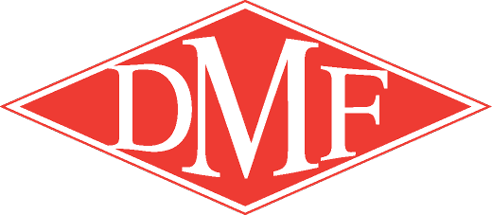Materials: All structural members and brackets are constructed of carbon steel. The 14″ guide wheels for DMF RW-1420 railgear are machined from hardened steel castings and are fitted to high strength alloy steel axles with heavy-duty tapered roller bearings.
Installation: Both DMF front and rear guide wheel units bolt to the truck frame using only hand tools found in any shop. They are designed to minimize the amount of space required and in many cases fit within the existing boundaries of the vehicle. The front units, however, sometimes require a bolt-on frame extension to complete the installation. Rear RW-1420 railgear mounts below the top of the frame and directly behind the chassis spring hangers.
Brakes: The optional RW-1420 rail brakes are an external Cobra shoe style and can be either air or hydraulically actuated. In both cases, the rail brakes are applied simultaneously with the truck brakes when the operator presses the brake pedal assisting the existing vehicle brakes when in rail mode. Both systems also have a dashboard-mounted switch that permits the operator to enable or disable the rail braking system.
Air rail brakes use a truck-style air chamber to supply the clamping force. Supply pressure can come from the vehicle’s air system (preferred) or from an optional skid-mounted compressor. A pressure protection valve separates the railgear and the truck’s air system, preventing a failure in the rail brake system from adversely affecting truck braking.
The hydraulic rail brake option requires the installation of a hydraulic power unit to provide the braking force. When the dashboard mounted enable switch is turned on, the brake lamp signal is used as a trigger to run the pump and divert hydraulic pressure to the brakes assisting the existing vehicle brakes when in rail mode. A built in safety circuit protects the truck’s brake lamp system as well as the hydraulic power unit from excessive run times.
Operation: The truck is pulled onto a crossing and the wheels aligned to the tracks with attention being paid to the front. The operator then activates the hydraulic power unit by pulling the lever of the hydraulic valve to raise the railgear off of the pin-off device. The safety pins are removed and the lever pushed forward lowering the rail wheels to the track. The front gear will lift the front of the truck and go over-center. The rear is operated similarly. The gear is raised to lift the weight from the pin-offs, and the pins are removed. The gear is then lowered via the two-handled valve at the rear of the truck. Each spool may be operated independently to articulate the rear gear and engage the rail even if the rear wheels are not perfectly aligned. Once the rear gear is fully deployed, the pin-offs are re-inserted to lock the gear in place.
Steering Wheel Lock: The steering stop is provided with the optional rail wheel brake assembly, as in the RW-1630 gear. If the unit is not equipped with optional brakes, a steering wheel lock is provided, requiring no modifications to the column.
